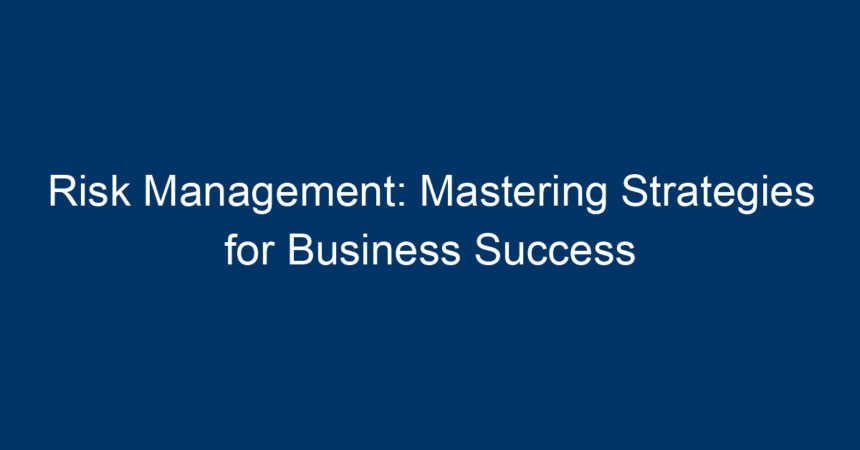In today’s volatile business landscape, successful organizations are no longer relying solely on traditional risk management frameworks. Instead, they are adopting innovative strategies that integrate risk management into their overall business processes. This proactive approach allows companies to not only mitigate potential threats but also capitalize on opportunities. In this comprehensive guide, we will delve into the importance of risk management and master effective strategies that can lead to business success.
Understanding Risk Management
What is Risk Management?
Risk management refers to the systematic process of identifying, assessing, and mitigating risks that could negatively impact an organization’s ability to achieve its objectives. This process involves not only recognizing potential threats but also understanding the inherent uncertainties within the business environment.
Why is Risk Management Important?
Effective risk management is crucial for several reasons:
-
Protection of Assets: By identifying and mitigating risks, organizations can protect their physical, financial, and intellectual assets.
-
Enhancing Decision-Making: A well-articulated risk management strategy provides leaders with the information they need to make informed decisions.
- Competitive Advantage: Businesses that employ proactive risk management strategies are often more resilient and agile, allowing them to adapt to changes in the market.
Common Types of Risks in Business
Organizations face various types of risks, including:
- Strategic Risks: Changes in market dynamics that jeopardize a company’s strategic objectives.
- Operational Risks: Risks arising from internal processes, systems, or human error.
- Financial Risks: Market fluctuations that can impact an organization’s financial health.
- Compliance Risks: Risks associated with non-compliance to laws and regulations.
Key Strategies for Effective Risk Management
1. Risk Identification
The first step in mastering risk management is identifying potential risks. Businesses can use several techniques to uncover risks, including:
-
Brainstorming Sessions: Gather a diverse group of stakeholders to discuss potential risk factors.
-
SWOT Analysis: Conduct a SWOT analysis (Strengths, Weaknesses, Opportunities, Threats) to identify internal and external risks.
- Scenario Planning: Envision various market scenarios to pinpoint risks that may not be immediately apparent.
2. Risk Assessment
Once risks have been identified, the next step is assessment. This involves evaluating the likelihood and impact of each risk using tools like:
-
Risk Matrix: A risk matrix helps visualize risks based on their severity and likelihood.
-
Qualitative Assessment: Evaluate risks based on expert judgment and historical data.
- Quantitative Assessment: Use statistical models to estimate the financial impact of risks.
3. Risk Mitigation Strategies
After assessment, businesses must develop effective risk mitigation strategies to minimize risk exposure:
-
Avoidance: Altering plans to eliminate risk entirely.
-
Reduction: Implementing measures to reduce the likelihood or impact of the risk.
-
Transfer: Shifting the risk to a third party, such as through insurance.
- Acceptance: Acknowledging the risk and its potential impacts; often used for low-probability risks.
4. Implementation of Risk Management Framework
A structured framework ensures systematic handling of risks. Popular frameworks include:
-
COSO ERM Framework: Focuses on enterprise risk management that integrates with overall business strategy.
- ISO 31000: Provides guidelines and principles for risk management applicable to any organization.
5. Continuous Monitoring and Review
Risk management is not a one-time task but an ongoing process. Regularly monitor risks and review risk management strategies through:
-
Regular Audits: Conduct audits to assess the effectiveness of risk management procedures.
-
Feedback Loops: Create mechanisms for stakeholder feedback on risk management practices.
- Data Analysis: Leverage data analytics to identify emerging risks and patterns.
The Role of Technology in Risk Management
Leveraging Technology
In the digital age, technology plays an indispensable role in risk management. Emerging tools and technologies that can enhance risk management include:
-
Risk Management Software: Systems that automate risk assessment, monitoring, and reporting.
-
Big Data Analytics: Use of data analytics to predict risk trends and assess risk exposure.
- Artificial Intelligence: AI can analyze vast amounts of data to identify patterns associated with risks.
Cybersecurity and Risk Management
In an increasingly digital world, cybersecurity has become a cornerstone of risk management. Protecting sensitive data from cyber threats involves:
-
Regular Security Audits: Assessing cybersecurity measures and protocols regularly.
-
Employee Training: Providing staff training to recognize and respond to potential cyber threats.
- Incident Response Plans: Developing robust plans to swiftly address any security breaches.
Actionable Insights for Businesses
-
Integrate Risk Management into Corporate Culture: Foster a culture where risk awareness and management are prioritized at all organizational levels.
-
Train Employees: Regular training on risk management practices can empower employees to identify and report potential risks.
-
Engage with Stakeholders: Collaboration with stakeholders is key. Regularly engage with customers, partners, and employees to gather insights on potential risks.
-
Stay Updated on Regulatory Changes: Businesses should keep abreast of regulatory changes that may impact risk exposure.
- Utilize Scenario Planning: Regularly conduct scenario planning exercises to prepare for unexpected events.
Conclusion
Mastering risk management is not just about thwarting potential threats; it’s about creating opportunities for innovation and sustainable growth. By implementing a robust risk management strategy, organizations can protect their assets, enhance decision-making, and gain a competitive edge. Take these actionable insights and integrate them into your business processes to ensure that you are not only prepared for the unexpected but also positioned for success.
Investing in effective risk management today will pay dividends in resilience and agility tomorrow. In a world where uncertainty reigns, mastering risk management isn’t just a strategy—it’s a pathway to lasting business success.




